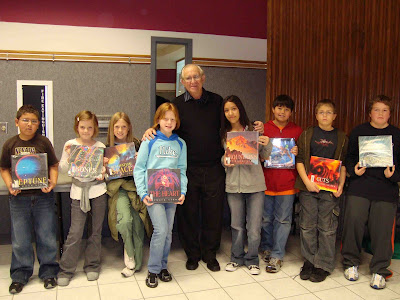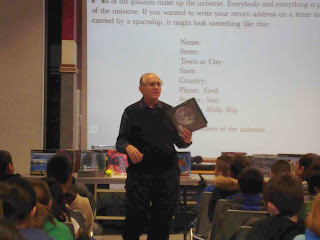Label: Universe
November 30, 2011
Niskayuna Student Writing
Wow! After I spoke at the morning assembly at Craig Elementary School here in Niskayuna, NY, Ms. O’Sullivan’s third graders went back to their classroom and started writing. At the end of the day, they presented me with an envelope full of writing and drawings. These were lovely thank you notes, which I appreciated very much, but they were more than that. Each student wrote a full page about animals, space, science, my books and my presentation. What a bunch of good writers!
Here are some of their drawings and samples of their writing.
Ben set the scene with a drawing of me in the assembly, holding the little ball that I use to talk about space.

Dear Mr. Simon,
You were very enthusiastic! I like The Paper Airplane Book best.
- Grace
Every word you said sounded so interesting. I want to read a lot of books.
- Cyrus
 I know how hard it is to write all the time and make sure your facts are right. But I bet you take a lot of time online first before you start writing a book. I also bet you love astronomy!
I know how hard it is to write all the time and make sure your facts are right. But I bet you take a lot of time online first before you start writing a book. I also bet you love astronomy! - Paige
Cat drawing by Andy.
Here is a fact about the gray wolf: Their only predator is Man.
- Shae

Mars drawing by Ava
I read more than 30 of your books and want to download your digital books on my iPad.
- Your favorite little book kid, Chris.
Now I know more about nonfiction, and maybe I can make a book myself and it might be nonfiction just like you.
- Abby

Fun fact: every man who has ever walked on the Moon was an Eagle Scout.
- Ethan
Olivia’s drawing of me flying a paper airplane
I like space books too. I will try looking for the Space Monster book and read it.
- Bhaya
And perhaps best of all, the letters were all gathered together in an envelope that included their full return address, right down to the zip code for the universe! Do you know how to write your return address so that it includes your location in the universe? Click here to find out.

Earth and Moon by Michael
Posted by: Seymour Simon
February 3, 2011
Citizens of the Universe in Round Rock, Texas
I’m in Round Rock, Texas (outside of Austin) all week, and it is very cold! It is not snowing here so far, but it is very cold for this part of the country - 19 degrees as I write this! There have been rolling power outages throughout the state, as the grid tries to cope with the amount of electricity required to heat homes and businesses. The Round Rock school district has decided to do their part to take some pressure off the grid, so we’re starting two hours late this morning.
Several kids in the schools have asked me to remind them how you write your entire address as a citizen of the universe. Here is how you can do it yourself:
Your name
Street Address
City, State, Zip Code
Country
Planet Earth
Milky Way Galaxy
The Universe ∞
Who can tell me what the symbol after "The Universe" means, and why it is the perfect zip code for the universe? The first person to comment on this blog and give the correct answer will get a signed, autographed photo! I will mail it to you, using your "whole" address, because you are truly a citizen of the universe.
Stay warm!

Posted by: Seymour Simon
August 24, 2010
Exciting Discovery in Today’s Science News!
A very exciting discovery was announced today at the Observatoire de Haute-Provence, France.

Astronomers have detected a planetary system containing at least five - and maybe seven - planets that orbit a star called HD 10180, which is much like our own Sun. They say this is the "richest" system of exoplanets - planets outside our own Solar System - ever found.
Up until now, astronomers had known of fifteen systems with at least three planets, but never one that was this similar to ours in terms of the number of planets (seven as compared to the Solar System’s eight planets). The team also has evidence that the distances of the planets from their star follow a regular pattern, as also seen in our Solar System (this is known as the Titius-Bode law).
The star is 127 light years away, in the southern constellation of Hydrus.
Researchers used the HARPS (High Accuracy Radial velocity Planet Searcher) instrument at the European Southern Observatory to monitor light emitted from the system. The lead author of the paper, Dr. Christophe Lovis, explained how the planet searcher works. "If there is one planet it will induce a little movement - the star will come towards us and move away….and what works for one [planet] works for many." Using HARP, Dr. Lovis and his team were able to measure this complicated mix of movements and break it down into individual planets, calculating the mass of each planet and the path of its orbit.

Martin Dominik, one of the researchers on the project, told reporters why this discovery is so important to us here on Earth. "[This] marks the way towards gathering the information that will put our own existence into cosmic context."
I have been an amateur astronomer all my life, and was President of the Junior Astronomy Club at the American Museum of Natural History when I was in high school. I love science news stories like these - I guess that is why I’ve written as many books as I have about space. Kids can read more about stars and the exoplanets that orbit them in my book STARS.

Photo Credits for this Science News story:
The first photograph shows a close-up of the sky around the star HD 10180. The picture was created from photographs taken through red and blue filters and forming part of the Digitized Sky Survey 2. Provided courtesy of ESO.
The second image is an artist’s impression of the new solar system, also courtesy of ESO.
Posted by: Seymour Simon
February 25, 2010
A Visit to San Angelo, Texas
I was recently in San Angelo, Texas, where it was cold and raining and everyone was very happy about the weather. When you live in a drought-prone area like West Texas, I can understand why rain is a welcome event!
We (my wife Liz Nealon went with me) discovered that although San Angelo is a rather small city, there is a lot to see there. We visited the San Angelo Museum of Fine Arts, which is a gorgeous building with a permanent ceramics and silver collection that we enjoyed very much. We had lunch in historic San Angelo, at a restaurant called Miss Hattie’s Saloon, which had…let’s call it a "colorful" history in bygone days! And, we visited Fort Concho, where Pecos Bill was once the commander. The fort is a National Historic Landmark because it was the the home of the Buffalo Soldiers who were part of the 10th Cavalry, one of the two all-Black cavalry regiments who protected the Great Plains in the mid-1800s.
I was in San Angelo to speak at the 8th Annual Literacy Conference, held at Angelo State University. While I was there, I also spoke to a number of large groups of kids from the public schools in San Angelo. Here is a picture of me with a group of students from Holiman Elementary.
The kids were all bright, eager, and very smart. I told each group a story that is in one of my early books, THE LONG VIEW INTO SPACE, about the way I started writing my return address when I was their age. Here’s how I did it.
Name
Street Address
City
State
Zip Code
Planet Earth
Solar System
The Milky Way Galaxy
The Universe
Years ago, when this book first came out, I was on my way to visit a school in Ohio. I got a letter from a fifth grade boy who had been looking at this address, and told me that I forgot to put down the zip code for the universe. I asked the kids in San Angelo if they could guess what he thought the zip code for the universe should be. A student came up with the answer in every group I spoke to. They suggested that the zip code for the Universe should be ∞ - the symbol for infinity.
Try writing your complete address. You are truly a citizen of the universe (and make sure to include its zip code).
Posted by: Seymour Simon


